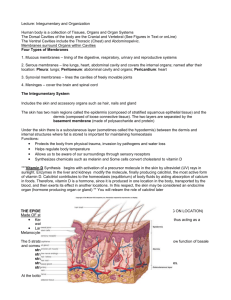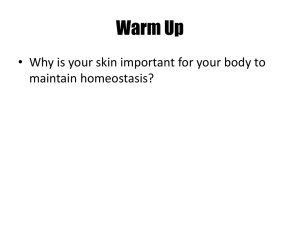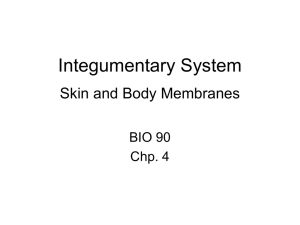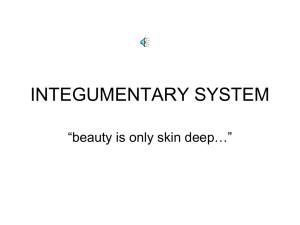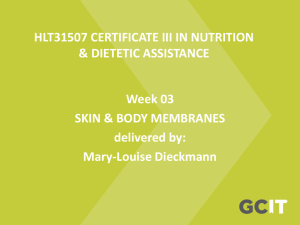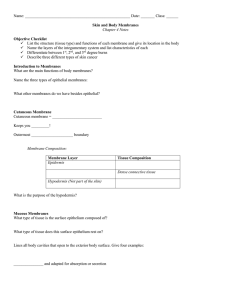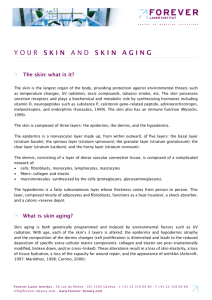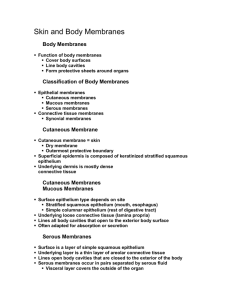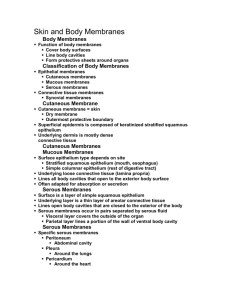Skin and Body Membranes
advertisement
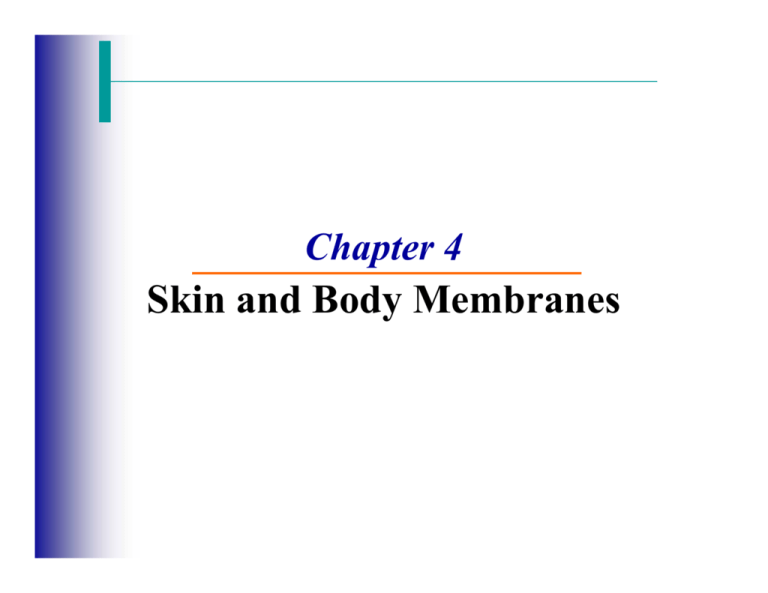
Chapter 4 Skin and Body Membranes Skin and Body Membranes • Function of body membranes • Line or cover body surfaces • Protect body surfaces • Lubricate body surfaces Classification of Body Membranes • Epithelial membranes • Cutaneous membrane • Mucous membrane • Serous membrane • Connective tissue membranes Cutaneous Membrane • Cutaneous membrane = skin • A dry membrane • Outermost protective boundary • Superficial epidermis • Keratinized stratified squamous epithelium • Underlying dermis • Mostly dense connective tissue Mucous Membranes • Surface epithelium • Type depends on site • Underlying loose connective tissue (lamina propria) • Lines all body cavities that open to the exterior body surface • Often adapted for absorption or secretion Serous Membranes • Surface simple squamous epithelium • Underlying areolar connective tissue • Lines open body cavities that are closed to the exterior of the body • Serous layers separated by serous fluid Serous Membranes • Specific serous membranes • Peritoneum • Abdominal cavity • Pleura • Around the lungs • Pericardium • Around the heart Connective Tissue Membrane • Synovial membrane • Connective tissue only • Lines fibrous capsules surrounding joints Integumentary System • Skin (cutaneous membrane) • Skin derivatives • Sweat glands • Oil glands • Hairs • Nails Skin Functions • Protects deeper tissues from: • Mechanical damage • Chemical damage • Bacterial damage • Thermal damage • Ultraviolet radiation • Desiccation Skin Functions • Aids in heat regulation • Aids in excretion of urea and uric acid • Synthesizes vitamin D Skin Structure • Epidermis – outer layer • Stratified squamous epithelium • Often keratinized (hardened by keratin) • Dermis • Dense connective tissue Skin Structure • Deep to dermis is the hypodermis • Not part of the skin • Anchors skin to underlying organs • Composed mostly of adipose tissue Layer of Epidermis • Stratum basale • Cells undergoing mitosis • Lies next to dermis • Stratum spinosum • Stratum granulosum Layer of Epidermis • Stratum lucidum • Occurs only in thick skin • Stratum corneum • Shingle-like dead cells Melanin • Pigment (melanin) produced by melanocytes • Color is yellow to brown to black • Melanocytes are mostly in the stratum basale • Amount of melanin produced depends upon genetic and exposure to sunlight Dermis • Two layers •Papillary layer • Projections called dermal papillae • Pain receptors • Capillary loops •Reticular layer • Blood vessels • Glands • Nerve receptors Normal Skin Color Determinants • Melanin • Yellow, brown or black pigments • Carotene • Orange-yellow pigment from some vegetables • Hemoglobin • Red coloring from blood cells in dermis capillaries • Oxygen content determines the extent of red coloring Appendages of the Skin • Sebaceous glands • Produce oil • Lubricant for skin • Kills bacteria • Most with ducts that empty into hair follicles • Glands are activated at puberty Appendages of the Skin • Sweat glands • Widely distributed in skin • Two types • Eccrine • Open via duct to pore on skin surface • Apocrine • Ducts empty into hair follicles Sweat and Its Function • Composition • Mostly water • Some metabolic waste • Fatty acids and proteins (apocrine only) • Function • Helps dissipate excess heat • Excretes waste products • Acidic nature inhibits bacteria growth • Odor is from associated bacteria Appendages of the Skin • Hair • Produced by hair bulb • Consists of hard keratinized epithelial cells • Melanocytes provide pigment for hair color Hair Anatomy • Central medulla • Cortex surrounds medulla • Cuticle on outside of cortex • Most heavily keratinized Associated Hair Structures • Hair follicle • Dermal and epidermal sheath surround hair root • Arrector pilli • Smooth muscle • Sebaceous gland • Sweat gland Appendages of the Skin • Nails • Scale-like modifications of the epidermis • Heavily keratinized • Stratum basale extends beneath the nail bed • Responsible for growth • Lack of pigment makes them colorless Nail Structures • Free edge • Body • Root of nail • Eponychium – proximal nail fold that projects onto the nail body Skin Homeostatic Imbalances • Infections • Athletes foot • Caused by fungal infection • Boils and carbuncles • Caused by bacterial infection • Cold sores • Caused by virus Skin Homeostatic Imbalances • Infections and allergies • Contact dermatitis • Exposures cause allergic reaction • Impetigo • Caused by bacterial infection • Psoriasis • Cause is unknown • Triggered by trauma, infection, stress Skin Homeostatic Imbalances • Burns • Tissue damage and cell death caused by heat, electricity, UV radiation, or chemicals • Associated dangers • Dehydration • Electrolyte imbalance • Circulatory shock Rules of Nines • Way to determine the extent of burns • Body is divided into 11 areas for quick estimation • Each area represents about 9% Severity of Burns • First-degree burns • Only epidermis is damaged • Skin is red and swollen • Second degree burns • Epidermis and upper dermis are damaged • Skin is red with blisters • Third-degree burns • Destroys entire skin layer • Burn is gray-white or black Critical Burns • Burns are considered critical if: • Over 25% of body has second degree burns • Over 10% of the body has third degree burns • There are third degree burns of the face, hands, or feet Skin Cancer • Cancer – abnormal cell mass • Two types • Benign • Does not spread (encapsulated) • Malignant • Metastasized (moves) to other parts of the body • Skin cancer is the most common type of cancer Skin Cancer Types • Basal cell carcinoma • Least malignant • Most common type • Arises from statum basale • Squamous cell carcinoma • Arises from stratum spinosum • Metastasizes to lymph nodes • Early removal allows a good chance of cure Skin Cancer Types • Malignant melanoma • Most deadly of skin cancers • Cancer of melanocytes • Metastasizes rapidly to lymph and blood vessels • Detection uses ABCD rule ABCD Rule • A = Asymmetry • Two sides of pigmented mole do not match • B = Border irregularity • Borders of mole are not smooth • C = Color • Different colors in pigmented area • D = Diameter • Spot is larger then 6 mm in diameter

